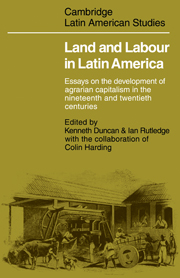 Land and Labourin Latin America
Land and Labourin Latin America Book contents
- Frontmatter
- Contents
- List of tables
- List of figures
- List of maps
- Acknowledgements
- 1 Introduction: patterns of agrarian capitalism in Latin America
- PART I THE TRANSITION FROM TRADITIONAL HACIENDA TO CAPITALIST ESTATE
- 2 Hacienda profits and tenant farming in the Mexican Bajío, 1700–1860
- 3 Landlord, labourer, and tenant in San Luis Potosí, northern Mexico, 1822–1910
- 4 Land and labour in rural Chile, 1850–1935
- 5 The development of the Chilean hacienda system, 1850–1973
- 6 Relations of production in Andean haciendas: Peru
- 7 The formation of the coffee estate in nineteenth-century Costa Rica
- PART II THE DEVELOPMENT OF A PLANTATION ECONOMY WITH LABOUR RECRUITMENT FROM HIGHLAND PEASANT COMMUNITIES
- PART III THE DEVELOPMENT OF COMMERCIAL AGRICULTURE USING EUROPEAN IMMIGRANT LABOUR
- PART IV THE TRANSITION FROM SLAVE PLANTATION TO CAPITALIST PLANTATION
- PART V POSTSCRIPT
- Glossary of Spanish and Portuguese terms used in the text
- Weights and measures
- Notes on contributors
- Indexes Subjects
- Authors
7 - The formation of the coffee estate in nineteenth-century Costa Rica
Published online by Cambridge University Press: 07 May 2010
- Frontmatter
- Contents
- List of tables
- List of figures
- List of maps
- Acknowledgements
- 1 Introduction: patterns of agrarian capitalism in Latin America
- PART I THE TRANSITION FROM TRADITIONAL HACIENDA TO CAPITALIST ESTATE
- 2 Hacienda profits and tenant farming in the Mexican Bajío, 1700–1860
- 3 Landlord, labourer, and tenant in San Luis Potosí, northern Mexico, 1822–1910
- 4 Land and labour in rural Chile, 1850–1935
- 5 The development of the Chilean hacienda system, 1850–1973
- 6 Relations of production in Andean haciendas: Peru
- 7 The formation of the coffee estate in nineteenth-century Costa Rica
- PART II THE DEVELOPMENT OF A PLANTATION ECONOMY WITH LABOUR RECRUITMENT FROM HIGHLAND PEASANT COMMUNITIES
- PART III THE DEVELOPMENT OF COMMERCIAL AGRICULTURE USING EUROPEAN IMMIGRANT LABOUR
- PART IV THE TRANSITION FROM SLAVE PLANTATION TO CAPITALIST PLANTATION
- PART V POSTSCRIPT
- Glossary of Spanish and Portuguese terms used in the text
- Weights and measures
- Notes on contributors
- Indexes Subjects
- Authors
Summary
The background
In any discussion of the development of the coffee economy in nineteenth-century Latin America, it is quite common to contrast the case of Brazil – with its moving frontier and the transition from slave labour to massive European immigration - with the situation in Spanish America, where land for coffee expansion was generally less abundant, and where a numerically significant immigration process did not occur. Nevertheless, even restricting ourselves to the Spanish American case, it is possible to identify significant variations in land tenure, labour patterns, and so on. Limiting our field still further to Central America alone, striking differences can be easily perceived between the history of coffee cultivation in Costa Rica – with its early origins, and with the absence of any large-scale process of land concentration, and its effects on the organization of the labour market – and the Guatemalan and Salvadorean experiences – in which coffee expansion only really got under way after a fierce struggle that set the new coffee bourgeoisie against the dominant social and economic groups inherited from colonial times, and which exhibited features of land and labour control altogether different from those found in Costa Rica. This essay deals mainly with the peculiarities of the Costa Rican case.
Geographical and ecological factors
The expansion of coffee production in nineteenth-century Costa Rica was restricted almost entirely to one small area, the intermontane valley known as the Meseta Central or Valle Central. Extending for 70 kilometres from west to east, and with an average width of 20 kilometres, the Meseta Central covers a total area of 2,700 square kilometres, at an average altitude of about 1,000 metres.
- Type
- Chapter
- Information
- Land and Labourin Latin AmericaEssays on the Development of Agrarian Capitalism in the nineteenth and twentieth centuries, pp. 165 - 202Publisher: Cambridge University PressPrint publication year: 1978


